
author : Han Xinzi @ShowMeAI
Tutorial address :http://www.showmeai.tech/tutorials/56
This paper addresses :http://www.showmeai.tech/article-detail/67
Statement : copyright , For reprint, please contact the platform and the author and indicate the source
Python Basic data types are generally divided into 6 Kind of : The number (Numbers)、 character string (String)、 list (List)、 Tuples (Tuple)、 Dictionaries (Dictionary)、 aggregate (Set). This article explains in detail Python Variable assignment in 、 Data type and conversion of data type .
The value of a variable stored in memory , This means that when you create variables, you open up a space in memory . Data types based on variables , The interpreter allocates the specified memory , And decide what data can be stored in memory . therefore , Variables can specify different data types , These variables can store integers , Decimal or character .
Python The variable assignment in does not require a type declaration .
Each variable is created in memory , All include the identification of variables , Name and data these information .
Each variable must be assigned a value before use , The variable will not be created until it is assigned a value .
Equal sign = Used to assign values to variables .
Equal sign = To the left of the operator is a variable name , Equal sign = To the right of the operator is the value stored in the variable . for example ( The following code can be found in On-line python3 Environmental Science Run in ):
num = 100 # Assign an integer variable
weight = 100.0 # floating-point
name = "ShowMeAI" # character string
print(num)
print(weight)
print(name)
In the example above ,100,100.0 and "ShowMeAI" Assign to respectively num,weight,name Variable .
Executing the above program will output the following results :
100
100.0
ShowMeAI
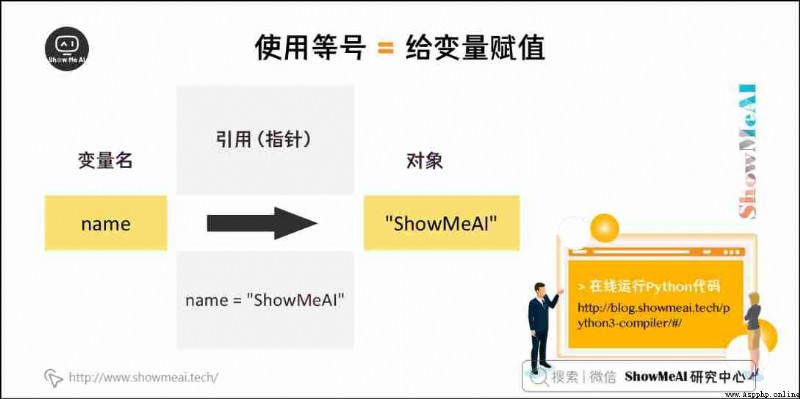
Python Allows you to assign values to multiple variables at the same time . for example :
a = b = c = 1
The above instance , Create an integer object , The value is 1, Three variables are allocated to the same memory space .
You can also specify multiple variables for multiple objects . for example :
a, b, c = 1, 2, "ShowMeAI"
The above instance , Two integer objects 1 and 2 Assign to variables separately a and b, String object "ShowMeAI" Assign to a variable c.
There can be many types of data stored in memory .
for example , A person's age can be stored in Numbers , His name can be stored in characters .
Python Some standard types are defined , Used to store various types of data .
Python There are the most commonly used 5 Standard data types :

Numeric data types are used to store numeric values .
They are immutable data types , This means that changing the digital data type assigns a new object .
When you specify a value ,Number The object will be created :
num1 = 1
num2 = 10
You can also use the del Statement to delete references to some objects .
del The syntax of the sentence is :
del num1[,num2[,num3[....,numN]]]
You can use the del Statement to delete references to single or multiple objects . for example :
del num
del num_a, num_b
Python Four different types of numbers are supported :
Some examples of numerical types :

String or string (String) It's numbers 、 Letter 、 A string of characters made up of underscores .
It is generally recorded as :
s = "a1a2···an" # n>=0
It's the data type that represents text in programming languages .
python The list of strings for has 2 The order of values is :

If you want to get a substring from a string , have access to [ Header subscript : Tail subscript ] To intercept the corresponding string , The subscript is from 0 From the beginning , It can be positive or negative , The subscript can be empty to indicate that the head or tail is taken .
[ Header subscript : Tail subscript ] The substring obtained contains the character of the header and subscript , But characters that don't contain trailing subscripts .
such as :
>>> s = 'ShowMeAI'
>>> s[6:8]
'AI'
When using colon delimited strings ,python Return a new object , The result contains consecutive content identified by this pair of offsets , The start on the left contains the lower boundary .
The above results include s[1] Value b, But not the maximum range Tail subscript , Namely s[5] Value f.
have access to __ plus (+)__ Connect strings , Use asterisk (*) Repeat the operation on the string . as follows ( The following code can be found in On-line python3 Environmental Science Run in ):
str = 'Hello ShowMeAI!'
print(str) # Output full string
print(str[0]) # The first character in the output string
print(str[2:5]) # A string between the third and sixth in the output string
print(str[2:]) # Output a string starting with the third character
print(str * 2) # Output string twice
print(str + " Awesome") # Output the string of the connection
The output of the above example :
Hello ShowMeAI!
H
llo
llo ShowMeAI!
Hello ShowMeAI!Hello ShowMeAI!
Hello ShowMeAI! Awesome
Python List interception can receive the third parameter , The parameter function is the step size of interception , The following examples are in the index 1 To the index 4 And set the step size to 2( One place apart ) To intercept a string :
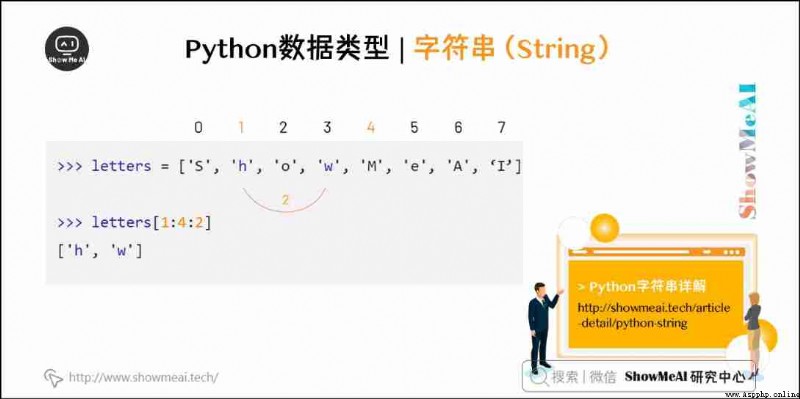
more python For the detailed explanation of string, please refer to python String and operation
List( list ) yes Python The most frequently used data type in .
List can complete the data structure implementation of most collection classes . It supports characters , Numbers , Strings can even contain lists ( That is, nesting ).
List with [ ] identification , yes python The most common composite data type .
The cutting of the values in the list can also use variables [ Header subscript : Tail subscript ] , You can intercept the corresponding list , Left to right index default 0 Start , Right to left index default -1 Start , The subscript can be empty to indicate that the head or tail is taken .
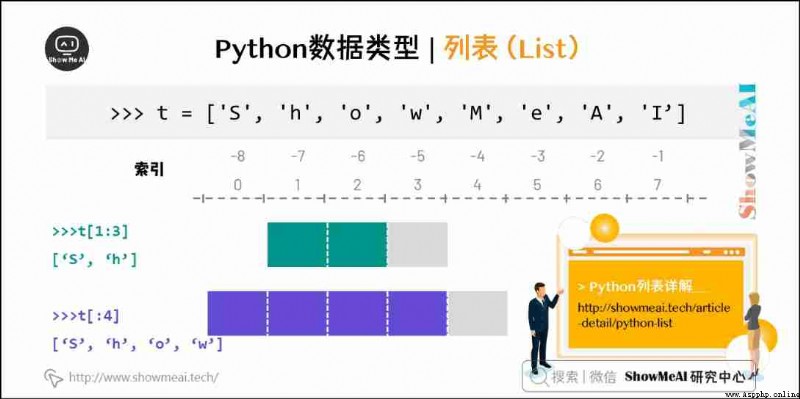

plus + Is the list join operator , asterisk ***** Is a repeat operation . as follows ( The following code can be found in On-line python3 Environmental Science Run in ):
list = [ 'ShowMeAI', 786 , 2.23, 'show', 70.2 ]
tinylist = [123, 'show']
print(list) # Output complete list
print(list[0]) # The first element of the output list
print(list[1:3]) # Output the second to third elements
print(list[2:]) # Output all elements from the third to the end of the list
print(tinylist * 2) # Output the list twice
print(list + tinylist) # Print a list of combinations
The output of the above example :
['ShowMeAI', 786, 2.23, 'show', 70.2]
ShowMeAI
[786, 2.23]
[2.23, 'show', 70.2]
[123, 'show', 123, 'show']
['ShowMeAI', 786, 2.23, 'show', 70.2, 123, 'show']
more python For the detailed explanation of the list, please refer to python list
Tuples are another data type , Be similar to List( list ).
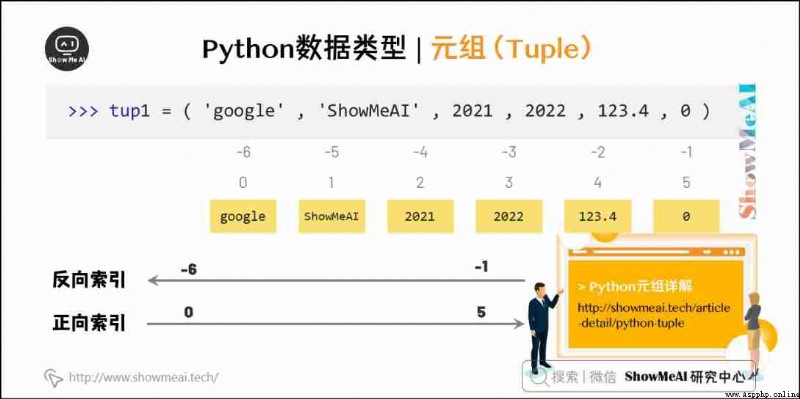
Tuple use () identification . The inner elements are separated by commas . But tuples cannot be assigned twice , Equivalent to read-only list .( The following code can be found in On-line python3 Environmental Science Run in )
tuple = ( 'ShowMeAI', 786 , 2.23, 'show', 70.2 )
tinytuple = (123, 'show')
print(tuple) # Output full tuples
print(tuple[0]) # The first element of the output tuple
print(tuple[1:3]) # Output the second to fourth ( It doesn't contain ) The elements of
print(tuple[2:]) # Output all elements from the third to the end of the list
print(tinytuple * 2) # Output tuples twice
print(tuple + tinytuple) # Print combined tuples
The output of the above example :
('ShowMeAI', 786, 2.23, 'show', 70.2)
ShowMeAI
(786, 2.23)
(2.23, 'show', 70.2)
(123, 'show', 123, 'show')
('ShowMeAI', 786, 2.23, 'show', 70.2, 123, 'show')
The following is a tuple invalid , Because tuples are not allowed to be updated . The list is allowed to be updated :
tuple = ( 'ShowMeAI', 345 , 2.23, 'show', 456.2 )
list = [ 'ShowMeAI', 345 , 2.23, 'show', 456.2 ]
tuple[2] = 100 # Illegal application in tuple
list[2] = 100 # In the list are legitimate applications
more python For detailed explanation of tuples, please refer to python Tuples
Dictionaries (dictionary) Except for the list python The most flexible type of built-in data structure . A list is an ordered collection of objects , A dictionary is an unordered collection of objects .
The difference between the two is : The elements in the dictionary are accessed by keys , Instead of accessing by offset .
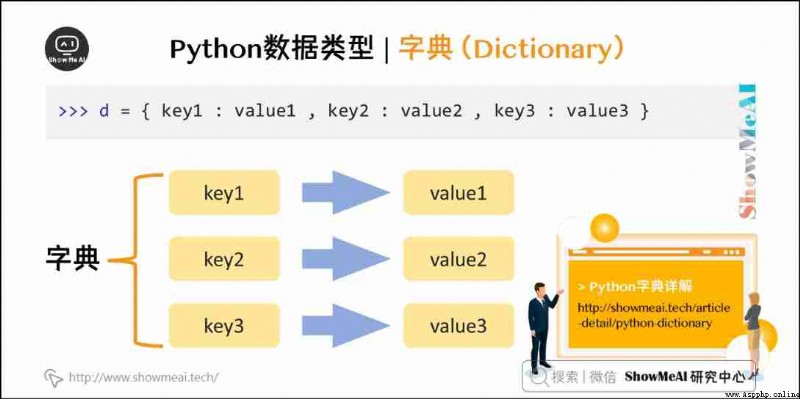
Dictionary use "{ }" identification . The dictionary is indexed by (key) The value corresponding to it value form .( The following code can be found in On-line python3 Environmental Science Run in )
dict = {}
dict['one'] = "This is one"
dict[2] = "This is two"
tinydict = {'name': 'ShowMeAI','code':3456, 'dept': 'AI'}
print(dict['one']) # The output key is 'one' Value
print(dict[2]) # The output key is 2 Value
print(tinydict) # Output complete dictionary
print(tinydict.keys()) # Output all keys
print(tinydict.values()) # Output all values
The output is :
This is one
This is two
{'name': 'ShowMeAI', 'code': 3456, 'dept': 'AI'}
dict_keys(['name', 'code', 'dept'])
dict_values(['ShowMeAI', 3456, 'AI'])
more python For the detailed explanation of the dictionary, you can refer to python Dictionaries
occasionally , We need to transform the built-in types of data , Conversion of data types , You just need to use the data type as the function name .
The following built-in functions can perform conversion between data types . These functions return a new object , Represents the value of the transformation .
Please click to B I'm looking at it from the website 【 Bilingual subtitles 】 edition
The code for this tutorial series can be found in ShowMeAI Corresponding github Download , Can be local python Environment is running , You can visit google Your baby can also use google colab One click operation and interactive operation learning Oh !
This tutorial series covers Python The quick look-up table can be downloaded and obtained at the following address :

Python Basic data type - list (list) And a tuple (tuple) And collection (set) author : Yin Zhengjie Copyright notice : Original works , Declined reprint ! Otherwise, the legal liability will be investigated . This blog uses Python3.6 edition , And what we'll share later ...
Python Basic data type - character string (string) author : Yin Zhengjie Copyright notice : Original works , Declined reprint ! Otherwise, the legal liability will be investigated . This blog uses Python3.6 edition , And every article I share in the future is Python3.x edition ...
Python Basic data type test questions Examination time : Two and a half hours Full marks 100 branch (80 Points above include 80 Pass score ) One , Basic questions . 1, Brief introduction to variable naming specification (3 branch ) 2, The relationship between bytes and bits ...
One .Python Basic grammar First use Python, First of all, we should clarify three points : Python Identifier ( For example, variable names . Function name, etc ), Available letters . Numbers and underscores make up , Cannot start with a number , And case sensitive . Python Sensitive to indentation . stay ...
python One of the basic data types list: 1. List creation list1 = ['hello', 'world', 1997, 2000] list2 = [1, 2, 3, 4, 5 ] list3 = ...
Python Basic data type - Dictionaries (dict) author : Yin Zhengjie Copyright notice : Original works , Declined reprint ! Otherwise, the legal liability will be investigated . This blog uses Python3.6 edition , And every article I share in the future is Python3.x Version of yo ...
Python Basic data type Exam time : three hours Full marks 100 branch (80 Points above include 80 Pass score )1, Brief introduction to variable naming specification (3 branch ) 1. It must be a letter , Numbers , Any combination of underscores . 2. Can 't start with a number 3. It can't be pytho ...
Python String of basic data type One .Python How to create a string stay python A string is formed by wrapping some text in quotation marks ( Quotation marks can be single quotation marks . Double quotes . Single three quotation marks , Double triple quotes , They are exactly the same ) >> ...
Python A collection of basic data types aggregate (set) yes Python One of the basic data types , It has a natural ability to remove weight , That is, the elements in the set cannot be repeated . Sets are also disordered , And the elements in the collection must be immutable types . One . How to create a collection #1 ...
Reprint # Python Basic data type test questions # Examination time : Two and a half hours Full marks 100 branch (80 Points above include 80 Pass score ) # One , Basic questions . # 1, Brief introduction to variable naming specification (3 branch ) # 1. Variables are made up of letters . Numbers . Underline any ...
Let's start with an introduction , I've been writing about cell phones recently h5 page , It's mainly about login and registration , The most difficult part is the form element . What I want to achieve is : There is a delete icon behind the input box , Events are triggered when something is entered , Show delete icon , Clicking on this icon will delete the previously entered content ...
Display row number . Number of words and bytes wc [options] [file-list] Parameters file-list yes wc List of pathnames of one or more files analyzed . If omitted file-list,wc Just read the input from the standard input Options ...
HPQC HP Quality Center windows If the service has been started , You don't have to run run.bat Both have the same effect .
Please indicate the author and source at the top of the page http://www.cnblogs.com/zhuxiaojie/p/7224772.html One : explain Here are some blog posts of big data series , If you have time, it will be updated one after another , Including big data ...
1. Three strings : (1)u'' Normal string ---> u'abc' ---> Default text mode , The output of text in characters (2)b'' Binary string ---> b'ASCII code ' -- ...
1. View the existing disk of the host # fdisk -l Now there's a piece in the mainframe 8G Of disks sdb, It has not been mounted in a partition , So you need to mount the disk by partition . 2. Partition the disk # fdisk /dev/sdb ( Select the partition you want to operate on ...
The proxy server acts as the internal network and Internet Security barriers between , send Internet Other people on the Internet can't access information on the intranet . What is agency ? In the basic network , The client makes a request to the server , The server sent back a response . The proxy server acts as a computer ...
Two knots RAC Environmental Science , database racdb example 1:racdb1 example 2:racdb2 1.IP planning name oracle-db1 oracle-db2PUBLIC I ...
Scala Advanced road - Use of collections of advanced data types author : Yin Zhengjie Copyright notice : Original works , Declined reprint ! Otherwise, the legal liability will be investigated . Scala There are three types of sets of : Sequence Seq. Set Set. mapping Map, All sets extend from ...
Heap size settings JVM There are three limits to the maximum heap size in : Data model of related operating system (32-bt still 64-bit) Limit : The available virtual memory limit of the system : The available physical memory limit of the system .32 A system. , The general limit is 1.5G~2G:64 For operation ...